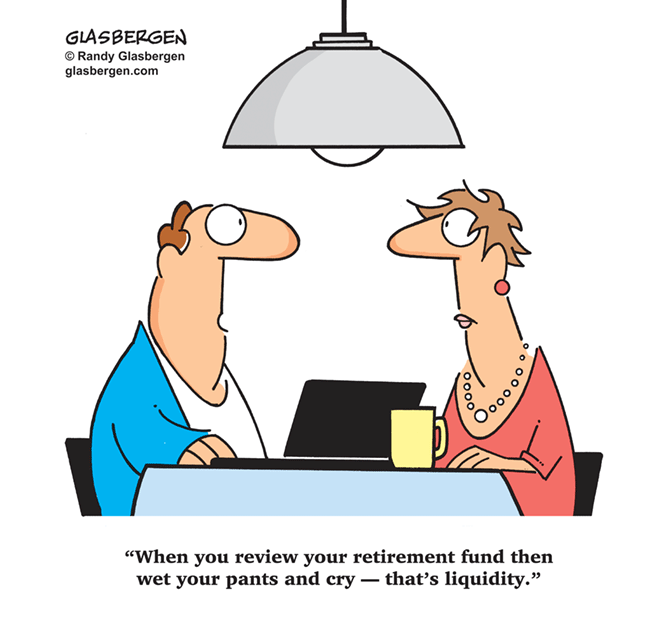

Happy Anniversary Kyle

Yesterday I had lunch with my pal Kyle who helps me and Paula with our retirement savings – it was 10 years to the day since Paula and I opened our account with his team to help navigate our journey from work to retirement. It is hard to judge success or failure on a single metric, but the 10-year return is 7.23% which is slightly greater than the target of 7% per annum that I set a decade ago.
As I have said before, I am fairly confident that I have saved enough for retirement and I am working simply because I love my work. With that said, in a DC world, it is good to periodically check-in on ‘the plan’ with ever changing investment markets and as our spending needs in retirement come into sharper focus as the kids move off the payroll. The other thing for me is that I am as much of an economics nerd as a math nerd and I just find the subject of macro-economics an impossible, but fascinating, puzzle. Kyle spends all his working time and a little more thinking about economics, so he is a good guy to indulge my imagination.
DIY Investing vs Advisors
Readers might be thinking that being surrounded by world class investment managers in my day job and having all the software and training to build a sound retirement plan, that I would surely be one of the folks in the DIY investment camp. In a nutshell, we use a professional advisor for three reasons: time, expertise, and removal of emotional decision making.
I have written in the past about the value of a good advisor and I stand by my premise that in the DC universe almost everyone needs someone to help them make investment choices and build a retirement plan. Online calculators are great but there is just so much nuance to individual circumstances that you need someone with robust software, time, and experience, to put together a good plan.
There are commission-based advisors and fee-based advisors and each approach has advantages and disadvantages. The key is to understand what you are paying for advice and to be aware of possible conflicts of interest. Good advisors are aware of conflicts, will tell you about them before you ask, and allow you to consider why the advice they are giving is good for you even if much of the time it is good for them too. The more money you save the more a commission-based advisor earns – but it also means you will have an easier time in retirement. In cases like this your interests are aligned.
The Return of DB
My friend Paul recently sent me an article postulating that the DB plan could make a comeback now that higher interest rates make pensions more affordable. There were three aspects of the article that stood out to me. One was the assertion that a DB plan could be a good tool for attracting and retaining workers. The second was the theory that with the higher interest rates that we are experiencing today it is more affordable to offer a DB plan. The third was the bold statement that “A modern employer cannot escape the responsibility of providing retirement benefits”. Let’s unpack these.
It is hard not to agree that a DB plan could be a great tool for attracting and retaining workers. After 30 years of the DC plan experiment, most workers would be happy to have someone else manage their savings and most importantly, guarantee that the result will be an adequate lifetime income in retirement.
The theory about higher interest rates making DB plan more affordable is a suspicious argument to me. Yes, higher interest rates mean that the cost of a given benefit level goes down. But higher interest rates also mean that savings in a DC plan can either earn a higher return or take less risk to achieve the same target. There is no magic that lets higher returns in a DB plan buy a bigger annuity than those same returns in a DC plan (ignoring the argument around fees).
The strength of the traditional DB plan was not in the investment return – it was in the smoothing of outcomes between plan members (longevity insurance) AND more importantly, the constant reminder by actuaries on the cost of delivering an adequate pension. Throw in the smoothing of employer contributions, before solvency funding and 1980’s accounting rules ruined that game, and everyone was happy. But all of that smoothing just masked the unpredictability of investment returns as well as the always changing cost of providing pensions. With the transparency in pension funding that we have today, employers are not going to take on the inherent investment risk unless there is a compelling HR motivation such as executives or union.
The last statement about modern employers unable to escape the responsibility for providing retirement benefits – this just sounds completely wrong to me. The modern employer HAS completely escaped the responsibility of providing retirement benefits. Employers expect only a small fraction of their workers to stay until retirement, so they give them their DC/RRSP dollars and send them on their way to the next employer. Like the childhood game of ‘hot potato’ it is only going to matter for the last employer how much someone has saved. Further, if someone comes to work for you at age 57 and can’t afford to retire at 65 you can just say, well I am only a small part of that problem because where are your savings from all your other employers? Ironically, in the war for talent that is coming, having a capable employee unable to afford retirement is now an asset and not a liability.
HOOPP recently published the paper Pensions in the Next Age of Uncertainty authored by Stephen Poloz. If you are having trouble placing the name, Mr. Poloz was the Governor of the Bank of Canada from 2013 to 2020 conveniently exiting the role just before all hell broke lose for interest rates in this country. The paper is an interesting, if not exciting read. Here are just three samples of the views the author shares:
“This is the proposition I lay out in my book, The Next Age of Uncertainty. I identify five tectonic forces that are shaping our future: population aging, technological progress, growing inequality, rising debt, and climate change, and consider their implications for the future.”
“I conclude that our future will be more volatile in general, verging on the unforecastable. Rather than one recession/recovery cycle every decade or so, there may be three. Job losses will become more frequent, usually for shorter intervals, but there will be an ongoing tug-of-war between a growing shortage of workers and a major labor-saving technological wave. Lifetime cumulative income will become far less certain for individuals. There will be bigger and more frequent interest rate and financial market fluctuations, a very challenging environment for investors and, by extension, for those saving for retirement. In short, retirement risk is on the rise.”
“Firms and individuals alike will willingly pay for protection from risk, and the rising tide of risk we can expect in the future will make them willing to pay more and more. This line of reasoning points strongly toward a natural renaissance of the DB pension plan in the years ahead, or at least something with a majority of those characteristics. A DB pension protects the beneficiary from unexpected inflation, from financial market volatility (investment risk), from longevity risk (outliving one’s savings), as well as from the risk of prematurely losing one’s breadwinning partner.”
I figure anyone who lands in charge of the Bank of Canada is a heck of a lot smarter than I am – and my guess is most Canadians would assume the same. With that said, I don’t get the leap of logic. Sure, the world is facing the ‘tectonic forces’ of change identified. Sure, our world will be even more ‘volatile in general, verging on the unforecastable’. But slow down cowboy, how did we figure out this is a world where DB plans can thrive?
We often hear about the survey where regular folks would give up pay for a better pension. I have said many times that I am doubtful this is accurate. Most private sector workers decline to increase their savings to company sponsored DC plans. Surely, they understand more money in today is more money out tomorrow. I think when this question is asked, what people hear is ‘do you want to give up 5% of pay for more pension worth 20% of pay?’. Heck yes, and I am glad we can ignore from where we find the extra 15% to fund the plan!
While I agree that a DB pension can protect individuals from the uncertainty and volatility of life, that protection comes at a price and someone has to pay it. If individuals want longevity insurance, they can buy an annuity – but they rarely do. If individuals want less volatility in investment outcomes, they can save more and take less investment risk – but they rarely do.
I just can’t reach the conclusion that in the emerging world that DB pensions will be the obvious solution. As I wrote last month, there is momentum towards target benefit plans – these are not DB plans and all the risks flow back to the employees, however, some risks like investment and longevity are pooled among the group creating some winners/losers within the club. But this isn’t DB which requires an entity at the end of the line to back the promises.
End Game
The lucky few will have a DB plan backed by taxpayers. The unlucky few will have no pension other than CPP and OAS. In the middle will be the many who have a target benefit plan or DC plan backed by individuals, either collectively or individually.
For those in the DC camp like me, saving for retirement is a long-term project. Ups and downs in employment, savings rates, investment returns, and expectations around the timing of retirement and the lifestyle that you expect to enjoy makes it hard to know how much to save each year. Although there is always a risk of saving too much, my advice is always to ‘spend less than you make’ and ‘save as much as you can’. Having enough savings to retire on your own timeline is incredibly valuable and my theory is that work is so much more enjoyable if you are there because you want to be and not because you have to be.



Comments